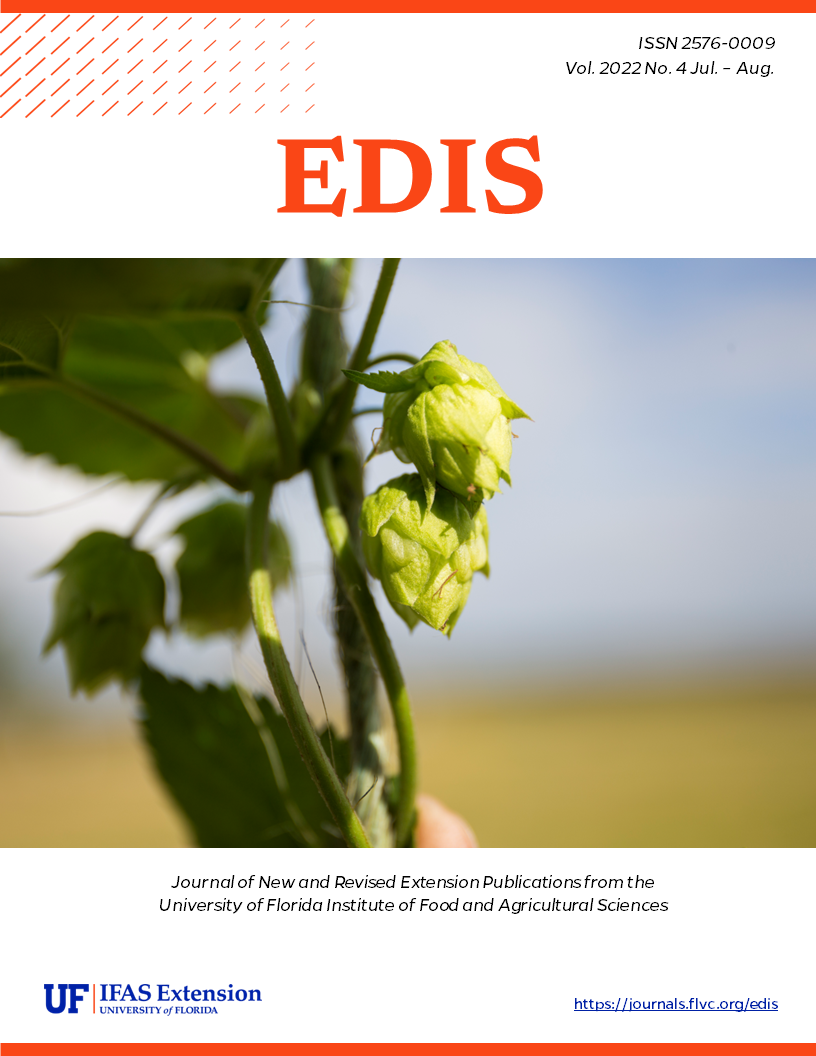Abstract
Meloidogyne enterolobii is an emerging destructive pathogen. The aim of this manuscript is to help growers be aware of the symptom, distribution, destructiveness and management measures of this nematode.
References
Alves GCS, de Almeida EJ, and dos Santos JM. 2009. Reaction of Coffea spp. to Meloidogyne mayaguensis. Nematologia Brasileira 33: 248-251.
Assoumana BT, Habash S, Ndiaye M, Van der Puije J, Sarr E, Adamou H, Grundler FMW, Elashry A. 2017. First report of the root-knot nematode Meloidogyne enterolobii parasitising sweet pepper (Capsicum annuum) in Niger. New Disease Reports 36: 18. https://doi.org/10.5197/j.2044-0588.2017.036.018
Baojun Y, Eisenback JD. 1983. Meloidogyne enterolobii n. sp. (Meloidogynidae), a root-knot nematode parasitizing pacara ear pod tree in China. Journal of Nematology 15(3): 381-391.
Brito JA, Powers TO, Mullin G., Inserra, RN, Dickson DW. 2004. Morphological and molecular characterization of Meloidogyne mayaguensis from Florida. Journal of Nematology 36(3): 232- 240.
Brito JA, Kaur R, Cetintas R, Stanley JD, Mendes M, McAvoy EJ, Powers TO, Dickson DW. 2008. Identification and isozyme characterisation of Meloidogyne spp. infecting horticultural and agronomic crops, and weed plants in Florida. Nematology 10(5): 757-766. https://doi.org/10.1163/156854108785787253
Brito JA, Kaur R, Cetinas R, Stanley JD, Mendes ML, Powers TO, Dickson DW. 2010. Meloidogyne spp. infecting ornamental plants in Florida. Nematropica 40(1): 87-104.
Brito JA, Smith T, Dickson DW. 2015. First report of Meloidogyne enterolobii infecting Artocarpus heterophyllus worldwide. Disease Notes 99(9): 1284-1285. https://doi.org/10.1094/PDIS-12-14-1292-PDN
Brito JA, Desaeger J, Dickson DW (2020). Reproduction of Meloidogyne enterolobii on selected root-knot nematode resistant sweetpotato (Ipomoea batatas) cultivars. Journal of Nematology. 52:1-6, https://doi.org/10.21307/jofnem-2020-063
Castagnone-Sereno P. 2012. Meloidognye enterolobii (= M. mayaguensis): profile of an emerging, highly pathogenic, root‐knot nematode species. Nematology 14(2): 133-138. https://doi.org/10.1163/156854111X601650
Castillo P and Castagnone-Sereno P, 2020. Meloidogyne enterolobii (Pacara earpod tree root-knot nematode). Invasive Species Compendium. Wallingford, UK: CABI. https://doi.org/10.1079/ISC.33238.20210200738
Edward OM, Moleleki L. 2013. Detection of Meloidogyne enterolobii in potatoes in South Africa and phylogenetic analysis based on intergenic region and the mitochondrial DNA sequences. European Journal of Plant Pathology 136(1):1-5. https://doi.org/10.1007/s10658-012-0142-y
Filho JVA, Machado JV, Dallagnol ACZ, Camargo LEA. 2016. Root-knot Nematodes (Meloidogyne spp.) parasitizing resistant tobacco cultivars in southern Brazil. Plant Disease 100(6): 1222-1231. https://doi.org/10.1094/PDIS-03-15-0341-RE
Freitas VM, Silva JP, Gomes C, Castro JC, Correa V, Carneiro RDG. 2016. Host status of selected cultivated fruit crops to Meloidogyne enterolobii. European Journal of Plant Pathology 148(2): 307-319. https://doi.org/10.1007/s10658-016-1090-8
Gomes CB, Couto MEO, Carneiro RMDG. 2008. Occurrence of Meloidogyne mayaguensis on guava and tabaco in south of Brazil. Nematologia Brasileira 32: 244-247.
Gu M, Bui HX, Ye W and Desaeger J 2021. The first report of Meloidogyne enterolobii on Thai basil in Florida, United States. Plant Disease https://doi.org/10.1094/PDIS-02-21-0293-PDN
Han H, Brito JA, Dickson DW. 2012. First report of Meloidogyne enterolobii infecting Euphorbia punicea in Florida. Plant Disease 96(11): 1706. https://doi.org/10.1094/PDIS-05-12-0497-PDN
Hu MX, Zhuo K, Liao JL. 2011. Multiplex PCR for the simultaneous identification and detection of Meloidogyne incognita, M. enterolobii, and M. javanica using DNA extracted directly from individual galls. Phytopathology 101(11): 1270-1277. https://doi.org/10.1094/PHYTO-04-11-0095
Jindapunnapat K, Chinnasri B, Kwankuae S. 2013. Biological control of root-knot nematodes (Meloidogyne enterolobii) in guava by the fungus Trichoderma harzianum. Journal of Developments in Sustainable Agriculture 8 (2): 110-118.
Kaur R, Brito JA, Dickson DW. 2006. First Report of Meloidogyne mayaguensis on Angelonia angustifolia. Plant disease 90(8): 1113. https://doi.org/10.1094/PD-90-1113A
Kiewnick S, Karssen G, Brito JA, Oggenfuss M, Frey JE. 2008. First report of root-knot nematode Meloidogyne enterolobii on tomato and cucumber in Switzerland. Disease Notes 92(9): 1370. https://doi.org/10.1094/PDIS-92-9-1370A
Kiewnick S. 2009. Effects of the Mi-1 and the N root-knot nematode-resistance gene on infection and reproduction of Meloidogyne enterolobii on tomato and pepper cultivars. Journal of Nematology 41(2): 134-139.
Moore MR, Brito JA, Qiu S, Roberts CG. 2020. First report of Meloidogyne enterolobii infecting Japanese blue berry tree (Elaeocarpus decipiens) in Florida, USA. Journal of Nematology 52: e2020-05. https://doi.org/10.21307/jofnem-2020-005
Overstreet C, McGawley EC, Clark C, Rezende J, Smith T, Sistrunk M. 2018. Guava root knot nematode a potentially serious new pest in Louisiana. Pub 3670. Baton Rouge: Louisiana State University AgCenter.
Rammah A, Hirschmann H. 1988. Meloidogyne mayaguensis n. sp. (Meloidogynidae), a root-knot nematode from Puerto Rico. Journal of Nematology 20(1): 58-69.
Rodriguez M, Sanchez L, Rowe J. 2003. Host status of agriculturally important plant families to the root-knot nematode Meloidogyne mayaguensis in Cuba. 2003. Nematropica 33(2): 125-130.
Rosa JMO, Westerich JN, Wilcken SRS. 2011. Reaction of maize hybrids and cultivars to Meloidogyne enterolobii and M. javanica. Nematologia Brasileira, 36(1): 9-14.
Rutter WB, Skantar AM, Handoo ZA, Mueller JD, Aultman SP, Agudelo P. 2019. Meloidogyne enterolobii found infecting root-knot nematode resistant sweetpotato in South Carolina, United States. Plant disease 103(4): 775. https://doi.org/10.1094/PDIS-08-18-1388-PDN
Ye W, Koenning SR, Zhuo K, Liao J. 2013. First report of Meloidogyne enterolobii on cotton and soybean in North Carolina, USA. Plant Disease 97(9): 1262. https://doi.org/10.1094/PDIS-03-13-0228-PDN
Schwarz T, Li C, Ye W, Davis E. 2020. Distribution of Meloidogyne enterolobii in eastern North Carolina and comparison of four isolates. Plant Health Progress 21(2): 91-96. https://doi.org/10.1094/PHP-12-19-0093-RS
Silva S, Carneiro RMDG, Faria M, Souza DA, Monnerat RG, Lopez RB. 2017. Evaluation of Pochonia chlamydosporia and Purpureocillium lilacinum for suppression of Meloidogyne enterolobii on tomato and banana. Journal of Nematology, 49(1): 77-85. https://doi.org/10.21307/jofnem-2017-047

